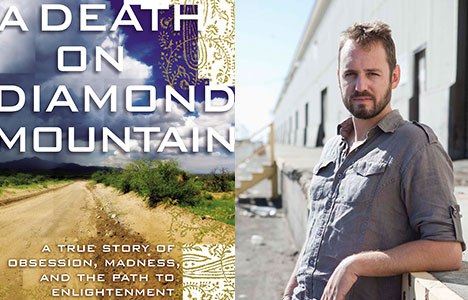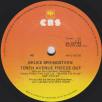Sunday I was relieved to be off of the road, as I’d spend all of Saturday cooped up in the car, counting the miles. Not feeling like doing anything active, I read Scott Carney’s Death on Diamond Mountain from page 22 until it concludes on page 246. The nonfiction book concerns the search for religious transcendence in contemporary society, through the story of Ian Thorson, a Buddhist who died in 2012.
Storyline & Drawbacks
Diamond Mountain is good, despite some shortcomings. Author Carney doesn’t always “center” his story. Too often, Ian Thorson – the book’s purported subject – slips entirely from view. By book’s end, Thorson is still a mysterious character, his motives murky to the reader. At best, you will be ambivalent about Thorson; while you might admire his desire to take life on his own terms, the fact remains that he abandoned two children and was violent toward women.

The book and author Carney
Another issue is author Carney’s tendency to go off on unrewarding tangents. His history of Buddhism is boring. Likewise, he drains the story’s momentum by including too much material on the history of native Americans in Arizona (near Diamond Mountain).
What Works
The good news is that the book is compelling and short. Carney builds a strong narrative around Thorson, from his Stanford graduation in 1995 his 2012 death. As long as Thorson is front and center, the book moves.
The villain in the story is Thorson’s spiritual leader, Michael Roach. Carney is quite harsh on Roach, an Eagle Scout and Princeton grad turned Buddhist lama. In Diamond Mountain, Roach is little more than a huckster, a Buddhist version of the televangelists who con people out of their money. Among many other sins, Roach ignores his vow of chastity to sleep with his young, female followers. Roach told one interviewer that having sex with his attractive, twenty-something wife was “…not fun. And it’s not a joke. It’s a life-or-death attempt to become a being who can serve all living creatures before you die” (p. 132).
Roach also chases every dollar that comes his way. During one retreat, he charged “retreatants” from $10,000 to $300,000 to build their cabins. At retreat’s end, the cabins belonged to Roach’s organization.
Also, Carney makes clear that Roach’s desire to maintain control of his followers played a role in Thorson’s death.
What the Story Tells Us
“Every great cause begins as a movement, becomes a business, and eventually degenerates into a racket.” ― Eric Hoffer, The Temper of Our Time
By book’s end, Roach seems to have gotten a comeuppance of sorts. At least in the United States, many people had come to agree that Hoffer had Roach and his organization pegged. Still, author Carney struggles to make sense of it all. He notes that spiritual pursuits change people, but not always for the better. However, for the most part, readers are left with few easy answers.
I give Death on Diamond Mountain 8 out of 10. It’s well worth a look.
Advertisements Like this:Like Loading... Related




